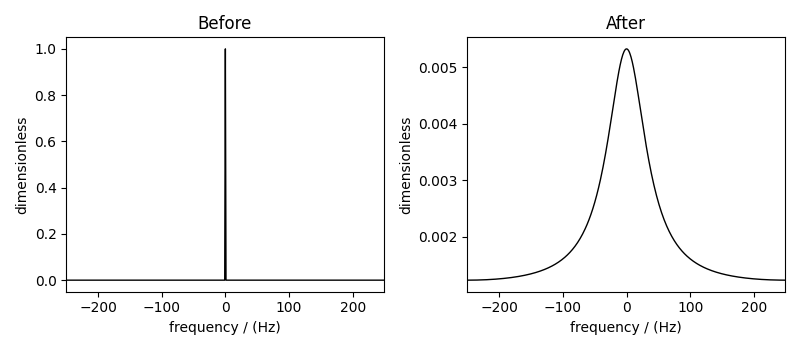Note
Click here to download the full example code
Exponential Apodization¶
In this example, we will use an exponential function to perform a Lorentzian convolution to an example dataset. The exponential function used for this apodization is defined as follows
where \(\sigma\) is parametrized by the the full width at half maximum as follows
Below we import the necessary modules
import csdmpy as cp
import numpy as np
from mrsimulator import signal_processor as sp
First we create processor, an instance of the
SignalProcessor class. The required
attribute of the SignalProcessor class, operations, is a list of operations to which
we add a Exponential object
sandwiched between two Fourier transformations.
processor = sp.SignalProcessor(
operations=[
sp.IFFT(),
sp.apodization.Exponential(FWHM="75 Hz"),
sp.FFT(),
]
)
Next we create a CSDM object with a test dataset which our signal processor will operate on. Here, the dataset spans 500 Hz with a delta function centered at 0 Hz.
test_data = np.zeros(500)
test_data[250] = 1
csdm_object = cp.CSDM(
dependent_variables=[cp.as_dependent_variable(test_data)],
dimensions=[cp.LinearDimension(count=500, increment="1 Hz", complex_fft=True)],
)
Now to apply the processor to the CSDM object, use the
apply_operations() method as
follows
processed_dataset = processor.apply_operations(dataset=csdm_object).real
To see the results of the exponential apodization, we create a simple plot using the
matplotlib library.
import matplotlib.pyplot as plt
fig, ax = plt.subplots(1, 2, figsize=(8, 3.5), subplot_kw={"projection": "csdm"})
ax[0].plot(csdm_object, color="black", linewidth=1)
ax[0].set_title("Before")
ax[1].plot(processed_dataset.real, color="black", linewidth=1)
ax[1].set_title("After")
plt.tight_layout()
plt.show()

Total running time of the script: ( 0 minutes 0.385 seconds)
